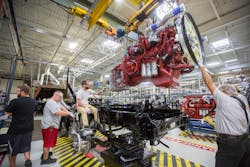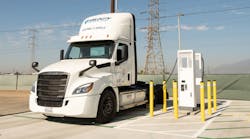What fuel source will dominate trucking in 2030?
Michael Roeth is constantly asked about the future of trucking. Leaders in the industry want to know what will fuel the freight movers of the future: diesel, battery-electric, or hydrogen fuel cells. So they turn to the executive director at the North American Council for Freight Efficiency.
“That’s because NACFE has been working to help the industry develop, deploy, and scale technologies to decarbonize freight for over a decade,” said Roeth, who moderated a “Future of Trucking” debate hosted by Mobility Impact Partners. “We've helped diesel trucks get from maybe six to eight to 10 miles per gallon hauling tens of thousands of pounds of goods around the country. We've been working on batteries and we have definitely done work in hydrogen fuel cells. So we feel like we understand these technologies.”
To better understand trucking’s potential future, Roeth welcomed three experts in diesel, battery-electric, and hydrogen to argue the case for which technology would be the primary fuel source for trucking by this decade’s end.
Diesel set up to dominate trucking for years
“Diesel dominates today’s commercial trucking fleets,” Allen Schaeffer, executive director at the Diesel Technology Forum, said during the debate, which was streamed live on LinkedIn on Feb 9. He added that the roughly 11 million diesel-powered trucks on the road today make up more than three-quarters of fleet vehicles. The rest are primarily gasoline-powered vehicles, with a small fraction running on battery-electric and hydrogen fuel cells.
“Diesel is the dominant technology—and the last two decades, diesel has really been defined by trying to reduce emissions,” Schaeffer said. “Today, I'm really proud to say that diesel is a technology that is near zero for both particulate matter and nitrogen oxide emissions—dramatically lower than it was several decades ago.”
About half of all commercial vehicles on the road today are running on the newest generation of diesel, he added. “That's important to recognize because these have delivered substantial benefits to society and the trucking industry since their inception; in terms of fuel savings and CO2 mitigation. The technologies are out there, and they’re doing a great job already in helping to reduce emissions nationwide.”
Those new diesel technologies, Schaeffer said, have reduced 202 million tonnes of CO2 since 2007, which is the equivalent of removing 43 million passenger vehicles from the road for one year. And that’s just part of the reason why he believes fleets will still be primarily relying on diesel between today and 2030. He laid out five fundamental reasons diesel will continue to dominate the industry this decade:
Availability and performance: “Diesel meets the demands of today's trucking industry,” Schaeffer said. “That's the range of operation. The nationwide access to fueling, servicing, parts, and many other aspects of the fleet operation.”
More efficient: “It's a technology that is more efficient and even lower emissions—with even more progress planned, based on some new regulations coming out.”
Uncertainties inherent in alternatives: “There is a very high threshold cost, and still considerable uncertainties inherent in the other alternatives: hydrogen and electrification. Most of these center around issues regarding infrastructure, range of operation, secondary life for batteries, and other kinds of considerations.”
Industry design: “The trucking industry's design and the market really demand more diesel. And even with some of the direct policy interventions that have been taking place in California, particularly with their advanced clean truck rule in 2035, California will only require 40% of Class 8 tractors to be zero-emission vehicles. So that means that 60% in 2035 are still going to be diesel in California, which is leading the policy space here.”
Time: “It’s 2022; we’re eight years away. I think it would take a monumental shift to see great displacement of diesel come 2030. I would even stretch that to say that if we’re talking about up to 2040, we might be having the same outlook.”
Diesel has staying power, Schaeffer contended because it is so prevalent today. There are 140,000 diesel fueling stations across the U.S., lending itself for million-mile operations. The alternate fuels have a long road to set up such a fueling network.
Electricity is the most efficient zero-emission energy
Scientist Colin Murphy, deputy director of the UC Davis Policy Institute, said the future of fleet fuel technology “is not an either/or debate; we’re just asking which one’s going to be the leader.” He said fleets would need a full portfolio of fuel technologies as the decade progresses.
Murphy sees battery-electric vehicles “dominating the Class 8 or long-haul space” because of climate change. “We have to get to zero-carbon transportation,” he said during the debate. “Climate change is already costing us over $100 billion and killing hundreds of people each year in the U.S.,” he said, citing a recent National Oceanic and Atmospheric Administration report.
“Climate change is no longer a future problem,” he added. “It’s no longer something to figure out how to change it, and it’s no longer something where we have to figure out when’s the right time to absorb the cost. Our choice is not: Do we pay money to go green or not? Our choice is: Do we pay money to reduce our carbon emissions or do we pay money to keep helicoptering people off roofs, rebuilding flooded towns, rebuilding fire-destroyed towns?
“It is absolutely essential that we get to zero carbon as soon as possible,” he continued. “Transportation is one of the major challenges on that.”
As a scientist focused on fuel-policy research, Murphy said he wants to follow the evidence. “The evidence says that across the on-road transportation sector—even in Class 8, the heaviest long-haul trucks—electricity has the best combination of cost-effectiveness and a pathway to get to zero,” he explained.
BEVs are already working, Murphy said. “There are hundreds of Class 7 and Class 8 battery-electric trucks on the road right now. Yeah, these are pilot demonstration products—but it’s enough that we’re getting a lot of real-world data, and these are showing themselves to be successful.”
Besides the just-emerging heavy-duty EV market, thousands of electric passenger buses are already on the road, along with 2.3 million light-duty EVs. “This is a technology that is not speculative, this technology that is actually in use and growing rapidly,” Murphy said.
While the upfront cost for EVs can be more expensive thanks to costly batteries, electricity itself is cheaper than other fuels, Murphy noted. “Electricity has a much lower cost per mile, delivering more travel efficiency,” he said. “And because electric vehicles don’t need to have nearly the same size radiator, transmission, exhaust, aftertreatment, and all these other ancillary systems, there’s a lot less maintenance involved.”
In California today, government incentives can help defray the upfront costs of EVs. By 2030, Murphy said that the total cost of ownership for Class 8 EVs will be competitive with other powertrains by 2030 without those government incentives.
And while technology might help diesel and hydrogen truly reach zero-carbon, Murphy said it would require more energy to get them there. “Electricity has the quickest, cheapest, and least risky pathway to get to zero—and that is absolutely critical,” he said. “When you directly electrify—you make electricity and put it into a battery and use the battery to drive a vehicle—the losses to friction and other sorts of fugitive energy losses are relatively low. It's a very efficient system with 70% to 80% end-use efficiency.”
Murphy said hydrogen is only half as efficient as battery electricity, noting that more energy is lost when making hydrogen through electrolysis. Then more is lost when it goes through the fuel cell. Even if there was a way to make a zero-carbon fluid to power diesel engines, Murphy said it would lose nearly two-thirds of its energy in heat losses.
“Knowing that we have to go and decarbonize the entire economy, knowing that we have to go and replace not all but basically all of the fossil-fueled energy generation systems that we have in the world—certainly in the U.S.—knowing that we have to go and build a tremendous amount of renewable electricity in order to meet the demands on the grid and also the demands of vehicles if you’re using electricity you have the most efficient way to get there.”
Hydrogen fuel cells' similarities to diesel
Hydrogen, as a fuel, has broad cross-sector adoption potential, according to Craig Scott, group manager at Toyota North America, which has developed a hydrogen fuel-cell electric Class 8 truck with the Kenworth Trucks, the T680FCEV.
“The verdict is clearly in,” Scott said. “Society must decarbonize in order to hopefully prevent any sustained long-term issues related to greenhouse gas emissions and a warming planet.”
Scott said that as hydrogen technology grows, so will its value. “As we make more compelling product offerings with fuel cells—be that a forklift to commercial vehicles to passenger vehicles to stationary power to airplanes to buses—fuel cells can meet all of these demands,” he explained. “They’re very scalable and very easily adapted to different applications.”
With that potential scaling up, hydrogen demand would grow and bring along an infrastructure to support it. “This has the virtuous effect of reducing costs of hydrogen for everyone throughout the value chain,” Scott said. “And that creates a wider and a deeper pool of products and applications that can use hydrogen, and around and around we go.”
He said that an echo chamber fuels all the BEV talk in the commercial vehicle industry. “Hydrogen quietly has been scaling very rapidly, not only in the U.S. but really across the globe. More than 350 terawatt-hours of low-carbon, renewable hydrogen supply has been announced by 2030—much of that in the United States.”
Along with more hydrogen-powered passenger vehicle models on the horizon, Scott said many large hydrogen infrastructure projects are underway in Europe and Asia. “There’s a very significant increase in hydrogen refueling stations across the world right now,” he said. “We didn’t go from horses to gasoline overnight. We’re not going to go from diesel to electricity and hydrogen overnight either.”
He added that the cost of hydrogen continued to fall over the past decade, unlike the prices of diesel, which he noted was more than $6 per gallon at a fueling station he drove past in Los Angeles that morning.
With $300 billion in hydrogen fueling investments planned this decade, fuel cells costs are expected to continue falling. The Class 8 T680FCEV tractor developed by Kenworth and Toyota is already in use at the Port of Los Angeles, hauling fully loaded trailers.
“The first fleet of these trucks, in just one and a half years, has accumulated 50,000 road miles,” Scott said. “Which I venture to guess is more than any other fleet of zero-emission trucks has in the world. These trucks are doing normal, daily routes, providing value to their operators and to their customers. It’s not a science experiment. It’s ready today.”
When it comes to making long-haul transportation zero-emissions, Scott contended that hydrogen fuel cells are the only option over the following decades. FCEVs have a similar weight to diesel trucks, he said, while BEVs can weigh 70% more because of the batteries.
FCEVs’ similarities to diesel give it an advantage in that long-haul space, Scott said. Refueling a hydrogen-powered Class 8 truck takes about the same time as diesel tractors. And both can cover the same distance between each refueling (300 to 500 miles). Battery-electric trucks, however, need hours to recharge and currently can’t get more than 100 to 300 miles per charge, he said.
The debate, which can be viewed here, was hosted by Mobility Impact Partners and co-hosted by Bain & Company, Credit Suisse, Autotech Council, Calstart, CoMotion, EPRI, NACFE, Diesel Technology Forum, UC Davis Policy Institute, and others.
About the Author
Josh Fisher
Editor-in-Chief
Editor-in-Chief Josh Fisher has been with FleetOwner since 2017. He covers everything from modern fleet management to operational efficiency, artificial intelligence, autonomous trucking, alternative fuels and powertrains, regulations, and emerging transportation technology. Based in Maryland, he writes the Lane Shift Ahead column about the changing North American transportation landscape.




